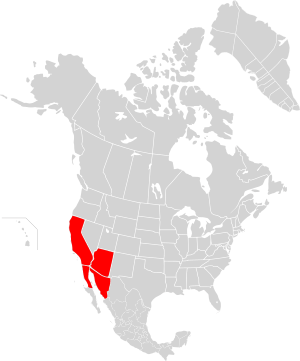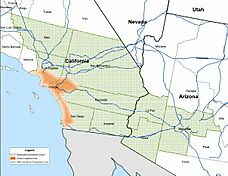2011 Southwest blackout facts for kids
The 2011 Southwest blackout, also known as the Great Blackout of 2011, was a huge power outage. It affected many areas, including San Diego and Tijuana, parts of southern Orange County, the Imperial Valley, Mexicali Valley, Coachella Valley, and parts of Arizona. This blackout started on Thursday, September 8, 2011, around 3:38 pm PDT. It was the biggest power failure in California's history.
Contents
How the Power System Was Set Up
Before the 2011 blackout, San Diego Gas & Electric (SDG&E) got its power from Arizona through a single large power line called the Southwest Power Link. This line carried 500,000 volts of electricity. SDG&E also connected to Southern California Edison (SCE) using five smaller 230,000-volt lines. These lines all went through the San Onofre Nuclear Generating Station (SONGS) switchyard. The Imperial Irrigation District (IID) also had its own power system connected to both SDG&E and SCE.
What Caused the Blackout
The blackout started because of a mistake by a technician. A main 500,000-volt power line in Arizona was accidentally turned off. This line was part of the Southwest Power Link, which supplied power to San Diego.
At first, the power company thought they could fix it quickly. But the line being off caused a big problem in the power grid. It meant the line could not be turned back on until the next day.
Most of San Diego's power then had to come through Southern California Edison's system, specifically through the SONGS switchyard. SDG&E's system started pulling much more power than the SONGS switchyard could handle.
Then, more problems happened. Two transformers in the Imperial Irrigation District (IID) overloaded and shut down. This caused very low voltage in IID's system. Soon after, another transformer tripped off, disconnecting most of IID's system from Southern California Edison. This led to a loss of about half of IID's power.
More transformers overloaded, cutting off the Yuma area from another power system. Yuma was then only getting power from San Diego and Imperial Valley. Finally, the last main connection to the east of SONGS tripped off. This left San Diego, Mexico, and Yuma almost completely cut off.
The remaining power lines overloaded. A safety system designed to prevent problems ended up making things worse. It turned off two power generators in Mexico. Then, the last remaining line also tripped off. Most of IID's power was lost.
All the power for San Diego, Baja California (Mexico), and Yuma (Arizona) was now trying to come through the SONGS switchyard. This was far too much power. A special "safety net" system at SONGS then disconnected the lines going into San Diego.
This meant SDG&E's system, Mexico's power system, and Yuma's power area were completely cut off from the main power grid. They did not have enough power being generated locally. In just seconds, San Diego, Mexico, and Yuma broke into three separate areas, and then all of them lost power completely. Even the two power units at SONGS shut down, but this happened after the main blackout had already started.
Impact of the Blackout
The blackout affected five different power companies. Nearly seven million people lost power. This included 1.4 million customers in San Diego County and 1.1 million customers in Mexico. The power outage was caused by 23 separate events that happened across 5 different power grids in just 11 minutes.
The San Diego-Tijuana metropolitan area was hit the hardest. Everything stopped. Streets became very crowded because traffic lights did not work. The San Diego Trolley system shut down. People in Tijuana and inland areas like the Coachella Valley stayed outside late into the night to escape the heat. Freeways became very jammed. One hospital lost power for two hours because its backup generator failed.
What Happened After
Eleven hours after the blackout began, power was back on for many customers. By 4:30 am the next day, September 9, power was restored to almost everyone. However, the system was still considered "fragile." As a safety measure, all public schools in San Diego County and some in Orange County were closed on September 9. Many universities and federal courts also closed for the day.
The blackout caused big losses for restaurants and grocery stores. They had to throw away a lot of spoiled food. It was estimated that food losses for stores and homes were between $12 million and $18 million.
Some sewage pumping stations also stopped working. This led to contaminated beaches and potentially unsafe water in some areas. As a precaution, some neighborhoods were told to boil their water or use bottled water for several days. Diesel generators were installed at five pumping stations to prevent future issues.
Was It Terrorism?
The blackout happened just days before the tenth anniversary of the September 11 attacks. Also, the United States Department of Homeland Security had warned about possible terrorist attacks around that time. So, some people first wondered if the blackout was caused by terrorism. However, the Federal Bureau of Investigation and SDG&E quickly said it was not terrorism. No evidence was ever found to suggest it was anything other than an accident.
Images for kids





